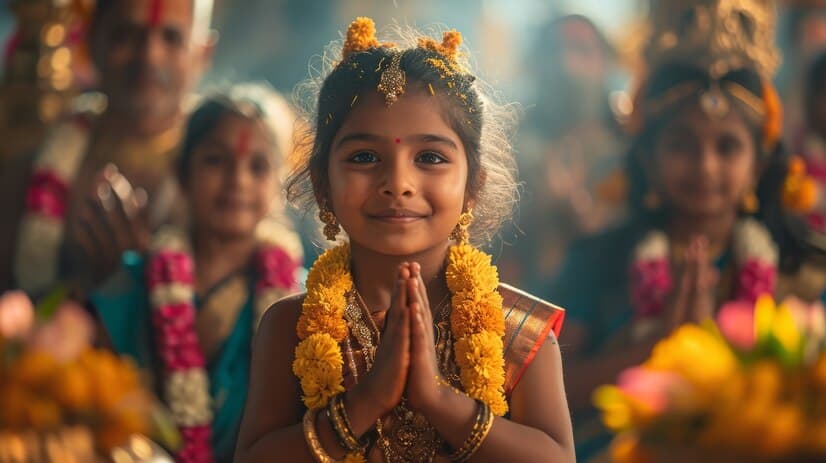
Informative
Spiritual Essence of Kanya Pujan in Navratri
There are few traditions in Sanatana that are just brilliantly straightforward, and yet they have a deep spiritual essence embedded in them. One such tradition is the tradition of Kanya Pujan during the Navratri festival, where 9 girls are invited to our homes and offered prayers and food, considering they are the embodiments of Maa Herself. In this blog, we are understanding the spiritual essence behind this age-old tradition and how to perform it.
Kanya Pujan during the Navratri
Devotees invite 9 girls to their homes during Navratri. According to the scriptures, a two-year-old girl is considered Maa Kaumari, a three-year-old girl is considered Divine Mother Trimurti (Goddess Durga, Lakshmi, and Saraswati), a four-year-old girl is Maa Kalyani, a five-year-old girl is Maa Rohini, a six-year-old girl is Mata Kalika, a seven-year-old girl is considered Maa Chandika, a girl of eight years is considered Maa Shambhavi, a girl of nine years is called Goddess Durga and a girl of ten years is called Maa Subhadra. At the time of Kanya Pujan, every girl is considered a symbol of latent energy, and it becomes active with the presence of all 9 girls. By worshiping them, Mother Durga arrives in the house, blessing the atmosphere.
During Kanya Puja, all these girls symbolize latent energy, and when we worship them, it’s believed that Mother Durga blesses our home. Kanya Puja involves worshiping these girls as if they are the nine forms of Goddess Durga. Sometimes, one or two boys are also included in the worship, representing Lord Bhairava and Lord Ganesha. Bhairava is considered the guardian of Mata Rani, and Lord Ganesha is included because no worship is complete without him. Completing the Kanya Puja and Bhairav Pujan is seen as a successful observance of the Navratri Vrat.
How is Kanya Pujan performed during Navratri?
The ritual of Kanya Pujan, also known as Kumari or Kanjak Puja, is considered very important during Navratri. Sadhaks perform Kumari Pujan on Ashtami Tithi or Navami Tithi. During this time, devotees who are following the Navratri rituals who perform Kanya Pujan at their homes should keep some special things in mind.
To begin the ritual, start your day early on the designated Ashtami or Navami Tithi and take a purifying bath. After that, kick off the worship by paying homage to Lord Ganesha and Mahagauri, following the prescribed rituals. This sets the spiritual tone for the upcoming Kanya Puja.
An important part of Kanya Puja is inviting nine young girls and two boys, all aged between 2 and 10 years. After washing their feet, apply Roli, Kumkum, and Akshat tilak on their hands and tie a sacred thread called Mauli to their wrists.
With a lamp brightening the sacred space, perform Aarti in the presence of both boys and girls, creating a spiritually charged atmosphere.
Serve pudding, Gram Dal, Puri, Kheer, vegetables, etc., to the invited guests according to your capacity. Remember not to pressure the girls and boys to eat. Whatever they consume, offer it with respect.
After the meal, give Dakshina (monetary donations) or gifts to the girls and boys based on your capacity. Cover the girls with a red Chunari, take blessings by touching the feet of the guests, and send them off while chanting praises to the Mother Goddess.
What is the spiritual essence of Kanya Pujan During Navratri?
Honoring the Divine Feminine: Kanya Pujan is a way to recognize and honor the divine feminine energy during Navratri, focusing on young girls as representatives of the Divine Mother.
Innocence and Purity: The ritual highlights the perceived innocence and purity of young girls. It symbolizes the untainted and divine qualities associated with the Maa.
Living Representation: By treating young girls as living representations of the goddess, devotees express their unconditional gratitude. They exhibit their reverence for the divine feminine in a tangible and relatable way.
Offerings and Gifts: During Kanya Pujan, people offer food, gifts, and other items to the girls. This symbolizes the act of giving back to the divine with the emotions of gratitude in a form that is present and accessible.
Seeking Blessings: Devotees seek blessings from the young girls, believing that their purity and connection to the divine can bring good luck, prosperity, and positive energy into their lives.
Cultural Tradition: Kanya Pujan is a cultural and religious tradition deeply rooted in Navratri celebrations. It represents a connection between the spiritual and everyday aspects of life.
Community Bonding: The ritual fosters a deep sense of community as people come together to perform Kanya Pujan, reinforcing social bonds and a shared celebration of spirituality.
Even though plenty of literature is available on spiritual practices, it is highly recommended that one learn these methods under the supervision of a Guru or an expert. Everyone has unique spirituality, personality, and experiences. One solution cannot fit all. Therefore, seeking guidance from spiritual experts is imperative to get that unique mantra, meditation, and spiritual method crafted exclusively for you for the spiritual awakening you seek. And hence, we recommend you practice these interpretations and practices mentioned above under the guidance of an expert.
Please subscribe to our mailing list to stay connected and receive spiritual information. In case of any queries, please write to us at info@chamundaswamiji.com. You can check out our YouTube channel Chamunda Swamiji where you can learn Tantra, Mantra, Yantra, and Meditation from His Holiness Shri Chamunda Swamiji. If you seek to learn Shakti Kriya, please register with us, and we will get back to you.
Post a Comment
-
Subscribe to Our Blog
-
Categories
-
Popular Articles
- Dead moth in the house. What universe is trying to tell you?
- Vivah Bandhan Curse – What Is It and How to Spiritually Heal It.
- Tripura Sundari | The Dasa Mahavidya
- What are Beej Mantras?
- The Dasa Mahavidyas
- Ramakrishna Paramhansa – The Man who almost became a Woman
- Maa Bhuvaneshwari | The Dasa Mahavidyas
- How does the Moon Affect Us?
- Maa Chinnamasta | The Dasa Mahavidyas
- Maa Bhairavi | The Dasa Mahavidyas



